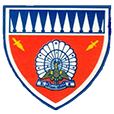Related Research Articles

Major General Deshabandu Bertram Russell Heyn was a Sri Lankan general and cricketer. He was a former Commander of the Ceylon Army.

The Sri Lanka Army is the oldest and largest of the Sri Lanka Armed Forces. Established as the Ceylon Army in 1949, it was renamed when Sri Lanka became a republic in 1972. In 2010, the Army had approximately 200,000 regular personnel, between 20,000 and 40,000 reserve (volunteer) personnel and 18,000 National Guardsmen and comprises 13 divisions, one air-mobile brigade, one commando brigade, one special forces brigade, one independent armored brigade, three mechanized infantry brigades and over 40 infantry brigades.

The Gemunu Watch (GW) ("King Dutugemunu's Own") is a infantry regiment of the Sri Lanka Army, formed with troops from the Ceylon Light Infantry and the Ceylon Sinha Regiment in 1962. It has been deployed in many major operations against the LTTE. It is made up of 14 regular units and 9 volunteer units. Headquartered at Kuruwita Army Camp, Ratnapura. It is named after one of the most famous Lankan Kings, King Dutugemunu.
General Hamilton Wanasinghe, VSV was a General in the Sri Lanka Army. He served as the 11th Commander of the Sri Lankan Army (1988–1991), third General Officer Commanding (GOC) of the Joint Operations Headquarters (JOH) (1991–1993) and Defense Secretary.
Colonel A. F. C. Vincent CMG was the 3rd Commander of the Ceylon Volunteers Force. He was appointed on 13 May 1896 and held the post till 1902 and again from 1902 to 14 March 1913 and 13 May 1913 to 31 May 1913. Two others, H. G. Morris and Gorden Fraser, acted in between his tenure. He was succeeded by R. B. Fell, as Commander of the Ceylon Defence Force.
Brigadier-General Robert Black Fell CB CBE was the 4th Commander of the Ceylon Defence Force. He was appointed on 1 June 1913 until 6 March 1914, and again until 31 December 1919. He was succeeded by the acting W. G. B. Dickson and again by Thomas Howard Chapman.
Lieutenant-Colonel W. G. B. Dickson was an acting Commander of the Ceylon Defence Force. He was appointed on 6 March 1914. He was succeeded by the acting Edward James Hayward.
Colonel Sir Edwin James Hayward, CBE, VD was a British soldier who was acting Commander of the Ceylon Defence Force. He was appointed on 6 March 1914.
Lieutenant-Colonel Thomas Howard Chapman, was director of public works of Ceylon and acting commander of the Ceylon Defence Force. He was appointed on 1 January 1920 until 21 July 1920. He was succeeded by F. M. G. Rowley.
Brigadier-General Frank George Mathias Rowley, was a British Army officer and the 5th Commander of the Ceylon Defence Force from 1920 to 1927.
Colonel George Bridges Stevens CBE VD was an acting Commander of the Ceylon Defence Force. He was appointed on 14 December 1928 until 28 April 1929. He was succeeded by Edward Bromfield Ferrers.
Colonel Edward Bromfield Ferrers DSO was the 7th Commander of the Ceylon Defence Force. He was appointed on 29 April 1929 until 3 March 1935. He was succeeded by Robert Burton Lesley.
Gordon Calthrop Thorne was an English first-class cricketer and British Army officer. Serving for most of his military career with the Royal Norfolk Regiment, Thorne saw action in the First World War from 1916 to 1918, before serving in British India and British Ceylon, where he served as the 9th Commander of the Ceylon Defence Force from 13 May 1937 until 5 February 1939. He served in the Second World War with the Cambridgeshire Regiment, seeing action during the Japanese invasion of Malaya, for which he was awarded the Distinguished Service Order, and in the Battle of Singapore. He escaped capture by the Japanese at Singapore aboard a Dutch steamship, but was killed in March 1942 when it was torpedoed by a Japanese submarine in the Indian Ocean. During his military career, he also played first-class cricket for the British Army cricket team.
Colonel T. G. Watson was the 11th Commander of the Ceylon Defence Force. He was appointed on 1 January 1942 until 1945. He was succeeded by R. A. McGeorge.
Colonel R. A. McGeorge was the 12th Commander of the Ceylon Defence Force. He was appointed in 1945 until 1946. He was succeeded by the acting Randolph Jewell Francis Mendis.
Colonel Randolph Jewell Francis Mendis, OBE, ED was a Ceylonese educationist. He served as the Deputy Director of Education, Acting Commandant of the Ceylon Defence Force and the first Ceylonese Commanding Officer, Ceylon Cadet Battalion.
General Gerard Hector "Gerry" de Silva, RWP, VSV, USP was a senior Sri Lanka Army officer. He is the 5th Chancellor of General Sir John Kotelawala Defence University since 20 January 2020. He was the 13th Commander of the Sri Lankan Army and Sri Lankan High Commissioner to Pakistan.
Air Chief Marshal Andibuduge Walter Fernando, VSV, ndc, psc was a senior Sri Lanka Air Force officer, who served as the 7th Commander of the Sri Lankan Air Force and thereafter Permanent Secretary to the Ministry of Defence.
Air Chief Marshal Makalandage Johnny Terrence "Terry" De Silva Gunawardena, VSV (-2014) was the 8th Commander of the Sri Lankan Air Force.
The chief secretary of Ceylon, was the chairman and one of three officers of state of the Board of Ministers of the State Council of Ceylon from 1932 to 1947. The post succeeded that of Colonial Secretary which was one of six offices that held a seat in the Executive Council of Ceylon until 1932.
References
- ↑ "Commandants". ceylondatabase.net. Archived from the original on 22 March 2014. Retrieved 21 March 2014.